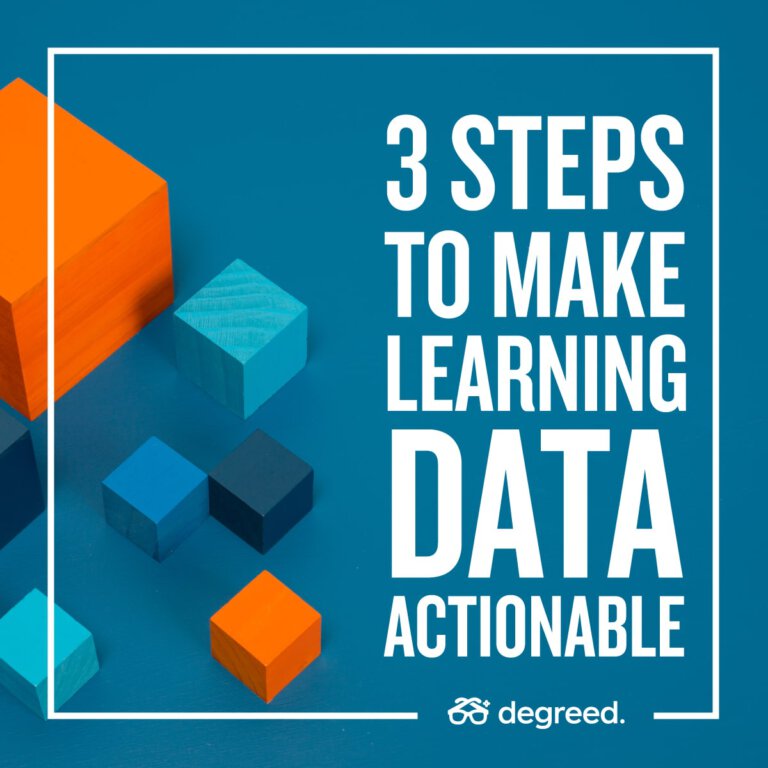
From Numbers to Insights: Three Steps to Make Learning Data Actionable
This is a summary of Interpreting Data: Turning Numbers into Insights, a session at LENS 2019. Find the full recording of the presentation at the bottom of this article.
In a world where Venmo processes $51,892 in transactions every sixty seconds and that same minute means almost 350,000 scrolls on Instagram, there’s no shortage of data. What is apparent is a shortage of the ability to turn that data into something meaningful, like an insight you can act on or a decision you can make.
This is as true for learning and development data as it is anywhere. Data is a tool, and like any tool, it’s only as good as its user. So our team has put together three steps to get hands-on with your learning data and start using it to show business impact and drive decision-making.
Step 1: Cozy up to Your Learning Data
Get to know your learning data by spending some time in it. This will do two things: get you comfortable with the tools you have, and create an understanding of the data you have available to you.
Here are some examples of ways to start getting familiar with your data:
- Get all of your data in one place, like a business intelligence (BI) tool or even an Excel spreadsheet.
- Explore the analytics and dashboard pages within your learning tools, and then try to recreate some of those graphs in your BI tool or Excel.
- Try to answer some basic questions by building graphs or pivot tables, e.g. during what month over the last year did people learn the most often? What content items are the most popular with your learners?
Step 2: Work Backward From an Action
A life coach named Rob Liano once said, “If you don’t know what you want, you’ll never find it.” We’re not here to talk about existential life lessons but we do know this: that statement is definitely true for learning data.
Data exploration — a process in which you jump into analysis with no specific questions in mind — is a great tool. But that’s generally better left for someone whose job is analysis and will have the necessary time and tools at their disposal.
Start any data analysis by defining an insight you want to draw or a hypothesis for what you’ll find, and then set out on the most direct path to find those insights or prove/disprove that hypothesis.
Step 3: Think Like a Data Designer
When you’re ready to take action on data, you might want or need to share the reasoning behind your decision with others. Data visualization designers communicate data for a living and they have great rules of thumb for this. Here are a few to keep in mind:
- Avoid tables and instead, use charts whenever possible.
- Give your charts titles that highlight the takeaways viewers should get from them for quick, succinct communication and clear value.
- Stay away from “no-no” graphs that are generally hard to understand, such as pie charts, donut charts, word clouds, and bubble graphs.
If you’re interested in learning more, Storytelling with Data, a fantastic book on the topic, is a great place to start.
Data is a commodity, and knowing how to work with data is a skill. By increasing your understanding of the data you have, using pointed questions to drive your analysis, and applying good data visualization techniques when you’re sharing your learnings, you’ll be able to take action on your learning data and see directly impactful results.
Watch the full presentation of Interpreting Data: Turn Numbers Into Insights below.
Unser heißer Draht zu Ihnen  .
.
Exklusive Einblicke, Infos zu bevorstehenden Veranstaltungen, Updates zu Degreed-Lösungen – das alles erwartet Sie in unserem monatlichen Newsletter.
Ihre Privatsphäre hat für uns oberste Priorität. Es ist Ihnen jederzeit möglich, Ihre Einstellungen für den Erhalt von E-Mails zu ändern oder Ihr Abonnement abzubestellen. Die von Ihnen bereitgestellten Informationen werden nur verwendet, um Ihnen Mitteilungen entsprechend Ihren Präferenzen zuzusenden. Weitere Einzelheiten hierzu finden Sie in der Degreed-Datenschutzerklärung.